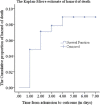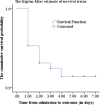Predictors of mortality among newborns admitted with perinatal asphyxia at public hospitals in Ethiopia: a prospective cohort study
- PMID: 34233643
- PMCID: PMC8261908
- DOI: 10.1186/s12887-021-02779-w
Predictors of mortality among newborns admitted with perinatal asphyxia at public hospitals in Ethiopia: a prospective cohort study
Abstract
Introduction: Perinatal asphyxia is a complicated newborn health problem and applies a high contribution to the increased proportion of newborn mortality. It occurs in newborns due to altered breathing or inadequate inhalation and exhalation resulting in reduced oxygen perfusion to certain body tissues and organs. Irrespective of the increased progress in health care towards newborns and implementations in reductions in under-five, infant, and neonatal mortality in the past 10 years, perinatal asphyxia remained as the most common severe newborn health challenge that causes a high number of morbidity and mortality.
Methods: A prospective cohort longitudinal study was implemented among 573 newborns admitted with perinatal asphyxia at public hospitals in Southern Ethiopia from 1st March 2018 to 28th February 2020. The perinatal survival time was determined using Kaplan Meier survival curve together with a log-rank test. The dependent variable was time to death and the independent variables were classified as socio-demographic factors, obstetrics related factors, newborn related factors and maternal medical related factors. The study subjects were entered in to the cohort during admission with perinatal asphyxia in the hospital and followed until 7 days of life.
Results: The cumulative proportion of survival among the newborns admitted with perinatal asphyxia was 95.21% (95%CI:91.00,97.48), 92.82% (95%CI:87.95,95.77), 92.02%(95%CI:86.84,95.22) and 90.78%(95%CI:84.82,94.48) at the end of first, second, third and fourth follow-up days respectively. The mean survival date was 6.55(95%CI: 6.33, 6.77) and cord prolapse (AHR:6.5;95%CI:1.18,36.01), pregnancy induced hypertension (AHR:25.4;95%CI:3.68,175.0), maternal iron deficiency anemia (AHR:5.9;95%CI:1.19,29.5) and having convulsion of the newborn (AHR:10.23;95%CI:2.24,46.54) were statistically significant in multivariable cox proportional hazard model.
Conclusion: The survival status among newborns with perinatal asphyxia was low during the early follow-up periods after admission to the hospital and the survival status increased after fourth follow up days. In addition, cord prolapse, history of PIH, maternal iron deficiency anemia and newborns history of convulsion were the independent predictors of mortality.
Keywords: Perinatal asphyxia, prospective study; Predictor of mortality; Southern Ethiopia.
Conflict of interest statement
All the authors declare that there is no any conflict of interest.
Figures



Similar articles
-
Incidence and predictors of mortality among neonates admitted with birth asphyxia to neonatal intensive care units in Ethiopia: a systematic review and meta-analysis.BMC Pediatr. 2025 Feb 26;25(1):140. doi: 10.1186/s12887-025-05481-3. BMC Pediatr. 2025. PMID: 40001015 Free PMC article.
-
The Kaplan Meier estimates of mortality and its predictors among newborns admitted with low birth weight at public hospitals in Ethiopia.PLoS One. 2020 Sep 11;15(9):e0238629. doi: 10.1371/journal.pone.0238629. eCollection 2020. PLoS One. 2020. PMID: 32915835 Free PMC article.
-
Birth asphyxia related mortality in Northwest Ethiopia: A multi-centre cohort study.PLoS One. 2023 Feb 24;18(2):e0281656. doi: 10.1371/journal.pone.0281656. eCollection 2023. PLoS One. 2023. PMID: 36827349 Free PMC article.
-
Survival and predictors of asphyxia among neonates admitted in neonatal intensive care units of public hospitals of Addis Ababa, Ethiopia, 2021: a retrospective follow-up study.BMC Pediatr. 2022 May 10;22(1):262. doi: 10.1186/s12887-022-03238-w. BMC Pediatr. 2022. PMID: 35538451 Free PMC article.
-
Transition to extrauterine life and the modeling of perinatal asphyxia in rats.WIREs Mech Dis. 2022 Sep;14(5):e1568. doi: 10.1002/wsbm.1568. Epub 2022 Jun 16. WIREs Mech Dis. 2022. PMID: 35712761 Review.
Cited by
-
Incidence and predictors of mortality among neonates admitted with perinatal asphyxia at west Oromia tertiary hospitals, Ethiopia, 2022.BMC Pediatr. 2023 Sep 19;23(1):475. doi: 10.1186/s12887-023-04313-6. BMC Pediatr. 2023. PMID: 37726683 Free PMC article.
-
Survival Status and Predictors of Mortality Among Asphyxiated Neonates Admitted to Jimma University Medical Center, Southwest Ethiopia: A Retrospective Cohort Study.Health Sci Rep. 2025 Feb 19;8(2):e70482. doi: 10.1002/hsr2.70482. eCollection 2025 Feb. Health Sci Rep. 2025. PMID: 39980830 Free PMC article.
-
Length of hospital stay and its factor associated among neonates with perinatal asphyxia in the Northwest Amhara Region, Northwest Ethiopia 2023: a multicentre retrospective cross-sectional study.BMJ Open. 2025 Feb 5;15(2):e087995. doi: 10.1136/bmjopen-2024-087995. BMJ Open. 2025. PMID: 39909526 Free PMC article.
-
Survival status and predictors of mortality among asphyxiated neonates admitted to the NICU of Dessie comprehensive specialized hospital, Amhara region, Northeast Ethiopia.PLoS One. 2022 Dec 21;17(12):e0279451. doi: 10.1371/journal.pone.0279451. eCollection 2022. PLoS One. 2022. PMID: 36542646 Free PMC article.
-
Incidence and predictors of mortality among neonates admitted with birth asphyxia to neonatal intensive care units in Ethiopia: a systematic review and meta-analysis.BMC Pediatr. 2025 Feb 26;25(1):140. doi: 10.1186/s12887-025-05481-3. BMC Pediatr. 2025. PMID: 40001015 Free PMC article.
References
-
- Pitsawong C, Panichkul P. Risk factors associated with birth asphyxia in Phramongkutklao hospital. Thai J Obstet Gynaecol. 2012;19(4):165–171.
-
- World Health Organization. Newborns: reducing mortality, 2018. Available: https://www.who.int/newsroom/fact-sheet/detail, Accessed 2 May 2018.
-
- Joy Lawn PM, Cousens S. Africa’s newborns–counting them and making them count. Opportunities for Africa’s Newborns. 2010.
MeSH terms
LinkOut - more resources
Full Text Sources
Miscellaneous

